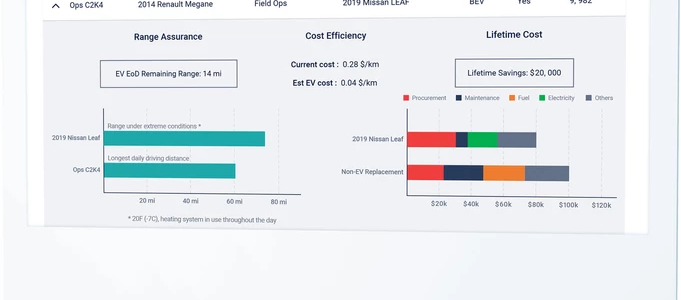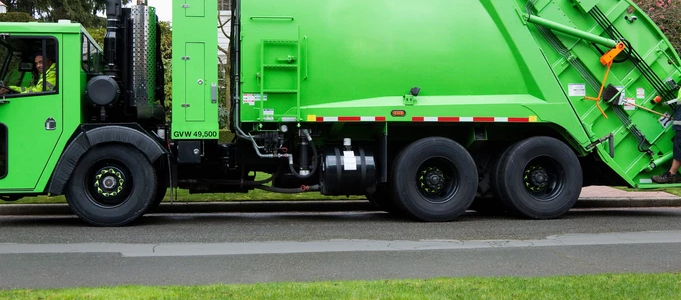How do I take my fleet electric? EV Sustainability Assessment
Thinking about replacing fuel cars with EVs? Find out which EVs are best suited to your fleet needs with our EVSA.
What is the EVSA?
Powered by the largest dataset for real-world EV performance, our EV Suitability Assessment offers data-driven EV recommendations to make your transition to electric as seamless as possible.
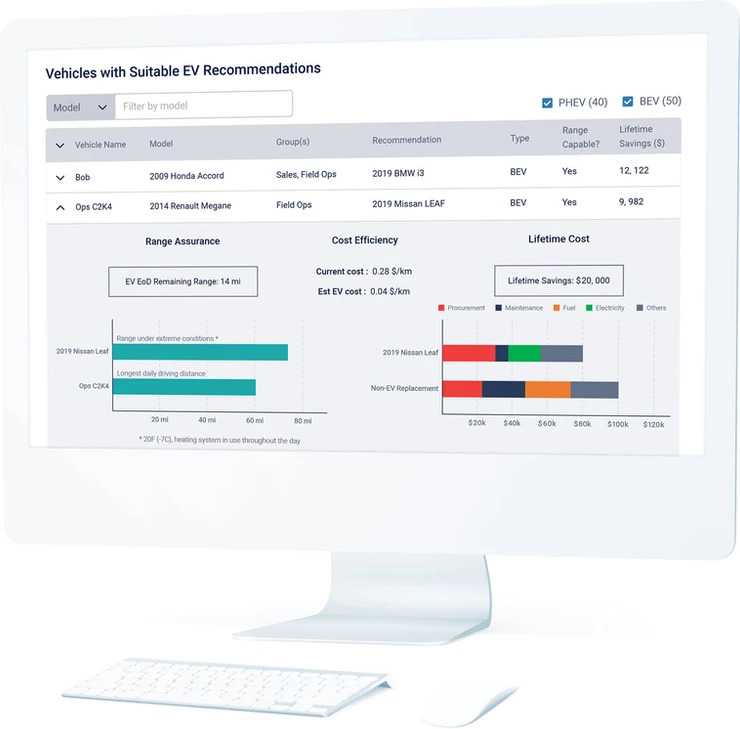
Analyze your fleet’s unique driving profiles and patterns to identify the vehicles in your fleet best suited for EV replacement. Receive personalized make and model recommendations that take into consideration: EV availability in the local market, EV performance in extreme weather conditions and financials related to procuring the EVs.
Receive a fleet electrification blueprint, which analyzes the total cost of ownership and reveals the potential cost-savings of switching to EVs in your fleet.
Financial analysis
Will going electric actually save you money? If so, how much? Discover the cost-savings potential and understand the total cost of ownership when switching to EVs.
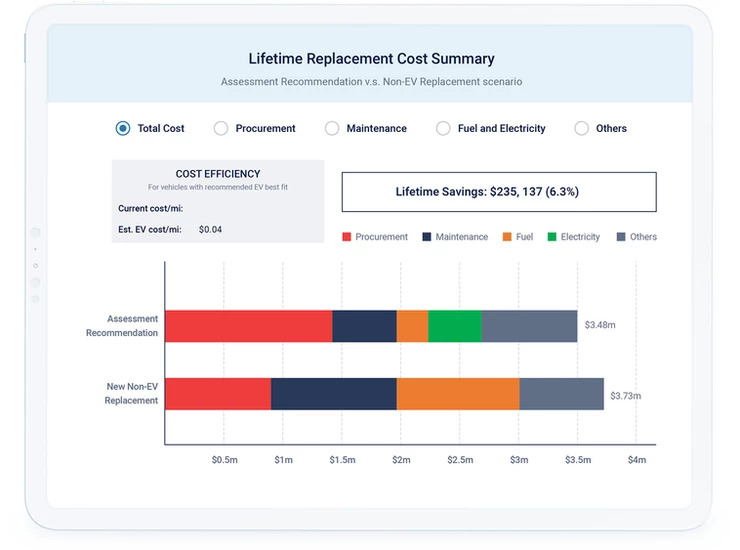
Range assurance
Silence range anxiety for good. Receive accurate EV make and model recommendations that are up for the task. This in-depth analysis, based on real-world EV performance data, checks if the battery will still cover your required range in extreme weather conditions.
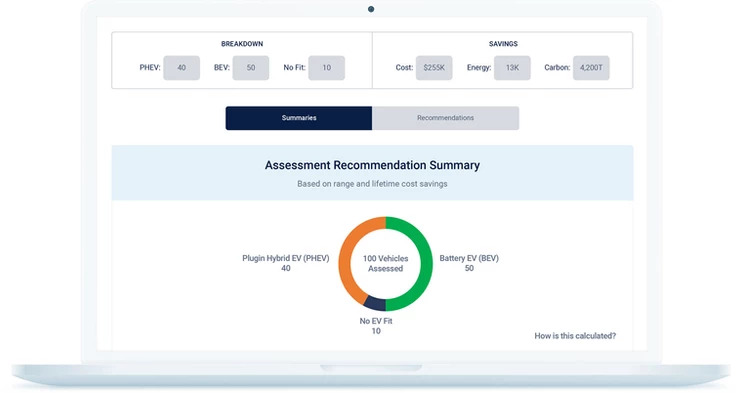
Environmental impact
Quantify the environmental benefits of switching to EVs. Find out how much your fleet’s carbon emissions will go down as well as the overall reduction in fuel compared to the fleet’s actual current stats.
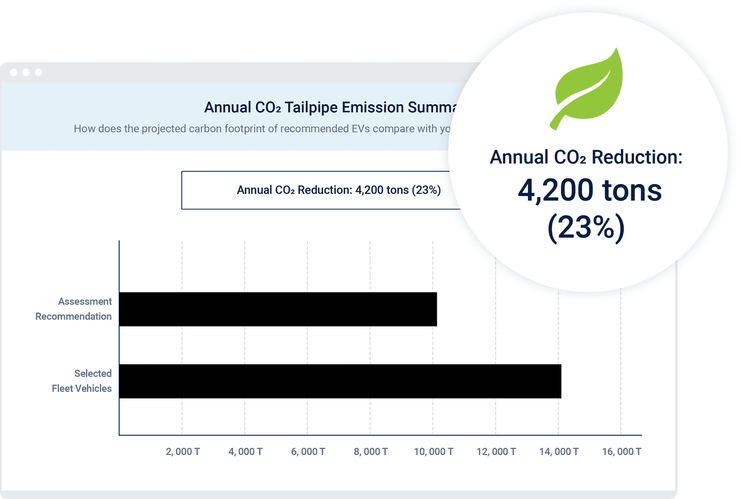
Benefits of the Geotab EV Suitability Assessment
-
Identify the best candidates for EV replacement based on actual driving profiles and real-world EV performance data
-
Learn which EVs make the most financial sense with a lifetime cost savings analysis
-
Understand how much your fleet can reduce CO2 emissions and fuel consumption
-
Ensure EVs have the range performance you require even in extreme weather conditions
-
Assess multiple electrification scenarios specific to your business quickly with the convenient do-it-yourself tool
Ready to electrify your fleet?
Get your free EV suitability assessment and make the switch to EVs with confidence by contacting us at info@advtracking.net
What is data cleaning and why does it matter?
No matter what type of data you work with — telematics or otherwise — data quality is important. Are you working with data to measure and optimize your fleet program?
Consider adding data cleaning to your regular routine. Here is a quick overview to get you started.
What is data cleaning?
Data cleaning is the process of ensuring data is correct, consistent and usable. You can clean data by identifying errors or corruptions, correcting or deleting them, or manually processing data as needed to prevent the same errors from occurring.
Most aspects of data cleaning can be done through the use of software tools, but a portion of it must be done manually. Although this can make data cleaning an overwhelming task, it is an essential part of managing company data.
What are the benefits of data cleaning?
There are many benefits to having clean data:
-
It removes major errors and inconsistencies that are inevitable when multiple sources of data are being pulled into one dataset.
-
Using tools to clean up data will make everyone on your team more efficient as you’ll be able to quickly get what you need from the data available to you.
-
Fewer errors means happier customers and fewer frustrated employees.
-
It allows you to map different data functions, and better understand what your data is intended to do, and learn where it is coming from.
See also: Do you have a big data graveyard?
Data cleaning in six steps
The first step before starting a data cleaning project is to first look at the big picture. Ask yourself: What are your goals and expectations? To achieve those goals you’ve set, next, you must plan a data cleanup strategy. A great guideline is to focus on your top metrics. Some questions to ask:
-
What is your highest metric looking to achieve?
-
What is your company’s overall goal and what is each member looking to achieve from it?
A good way to start is to get the key stakeholders together and brainstorm. Here are some best practices when it comes to create a data cleaning process:
1. Monitor errors
Keep a record of trends where most of your errors are coming from.This will make it a lot easier to identify and fix incorrect or corrupt data. Records are especially important if you are integrating other solutions with your fleet management software, so that your errors don’t clog up the work of other departments.
2. Standardize your process
Standardize the point of entry to help reduce the risk of duplication.
3. Validate data accuracy
Once you have cleaned your existing database, validate the accuracy of your data. Research and invest in data tools that allow you to clean your data in real-time. Some tools even use AI or machine learning to better test for accuracy.
4. Scrub for duplicate data
Identify duplicates to help save time when analyzing data. Repeated data can be avoided by researching and investing in different data cleaning tools that can analyze raw data in bulk and automate the process for you.
5. Analyze your data
After your data has been standardized, validated and scrubbed for duplicates, use third-party sources to append it. Reliable third-party sources can capture information directly from first-party sites, then clean and compile the data to provide more complete information for business intelligence and analytics.
6. Communicate with your team
Share the new standardized cleaning process with your team to promote adoption of the new protocol. Now that you’ve scrubbed down your data, it’s important to keep it clean. Keeping your team in the loop will help you develop and strengthen customer segmentation and send more targeted information to customers and prospects.
Finally, monitor and review data regularly to catch inconsistencies.
Get your ROI from data
If you are tasked with managing data, don’t overlook data cleaning. Keeping on top of consistent and accurate inputs is an essential everyday task. The steps outlined above should help make it easier to create a daily protocol. Once you have completed your data cleaning process, you can confidently move forward using the data for deep operational insights with your now accurate and reliable data.
Did you know that Geotab telematics data can be easily integrated into other systems? Contact us to find out how Advtracking.net/contact
How to Best Manage Your Biggest Fleet Cost
Do you know which is the top expense for most fleets today? You guessed it, it’s your fuel cost. On average, fuel makes up around a third of a fleet’s running costs. Because this cost impacts the bottom line of so many of our customers, we compiled five easy ways to cut on a fleet’s fuel bill:
1. Thoroughly analyze your fleet needs
Take time to do a full all-round working knowledge of your entire fleet including vehicles, drivers, customers, processes, systems, spend and regulations. Ask yourself questions such as:
-
Is your fuel purchased wholesale or at the pump?
-
What kind of vehicles are best for your operations?
-
Where and how are your fleet vehicles driven?
2. Your driver behavior makes a difference
How your drivers behave behind the wheel massively impacts how efficient your vehicles are. Speeding, irregular gear changes and hard braking can have a negative impact on fuel economy. Reducing speed is an easy way to cut costs.
3. Properly plan your routes
A vehicle can use a quarter of a gallon of fuel for every 15 minutes it idles so planning ahead can potentially lead to big savings. From assessing driver routes to analyzing the best places to refuel your vehicles, telematics can play an important part in effectively managing journeys and choosing the best routes. The ability to track and monitor vehicles helps avoid congestion where possible or prevent unnecessary journey overlap.
4. Regularly maintain your fleet
Keeping your vehicles in prime condition can help to reduce fuel costs. As an example, a car with under-inflated tyres can use 3% more fuel than one with the correct pressures. Ask your drivers to carry out daily walk-round checks of their vehicles to look out for issues such as under-inflated tires. Making sure that vehicles are fully serviced and maintained is also a big help in controlling fuel spend.
5. Keep track of any fuel irregularities
Fuel fraud is not as uncommon as you may think – discrepancies in mileage for vehicles or sudden increase in fuel spend needs investigating. A fleet fuel management system, such as Advantage Fuel Center, can play an important part in showing you of any irregularities in fuel costs, supporting a prompt and efficient investigation to quickly determine the cause.
As you turn your attention to your fuel costs, consider if the energy efficiency of your fleets is still working for you. A switch to alternative fuel choices such as electric or hybrid vehicles could deliver those essential cost savings without any loss in performance.
Integrating Data: Philips Connect EZTrac
Over the course of the last 92 years, Phillips Connect has built strong partnerships with a wide variety of companies including truck and trailer manufacturers, component makers, manufacturers of auxiliary equipment, and many others. There are many advantages to knowing the location of an asset: time saved, reduced unpaid miles (empty miles), increased driver productivity, and decreased operating costs. Which is why we are excited to share this information and special offer.
Phillips Connect EZTrac™ is an asset tracking system for trailers and chassis that’s super easy to install (as seen on the video below), has a user friendly dashboard and highly customizable reporting. A lot of the sensors are going to amplify each other from a management standpoint and anytime you can amplify data you are also amplifying your return on investment. When you have all the data in one place you can monitor the systems to see if they are healthy in ways that are not possible when the sensor was a standalone.
Looking ahead into the future, analytics are going to become more and more a larger part of the heavy duty trucking industry and other verticals alike as the demand to drive change and improve the bottom line for fleets around the world increases.
SPECIAL OFFER
We are offering EZTrac™ now until the end of the year (2021) with a no contract offer of $95 hardware and $9.95 a month subscription cost. If you’re ready to make a bigger commitment – a 36 month contract will get you free hardware with a $14 a month subscription cost. Contact our team today to learn more or to sign up for this special offer.
Using Telematics For Planned, Urgent and Emergent Activities
Public works are all around us. Roads, highways, drainage, water projects and sewers are all examples of public works activities undertaken by your town, county or state. Maintenance activities like snow and ice removal, solid waste pick up and pothole patching fall in this category too. Every community and individual has the same needs like disposing of their trash and clean water. When a community agrees to solve that problem collectively, public works begin.
To improve their operation, public works service agencies and contractors not only use the resources they have available, but plan for the future. Telematics solutions can absolutely improve both today’s operation and tomorrow’s planning.
There are different triggers for public works activity. Generally events fall into three categories: planned, urgent and emergent.
-
Planned events are those that occur based on time such as solid waste pick up, most street sweeping or mosquito fogging. They are predictable and make up the bulk of activity.
-
Urgent events are those that are expected but no one knows exactly when they are coming, such as snowfall or post storm debris removal.
-
Emergency events are those that are outside the normal scope of a public works agency’s planning. These include both Urgent events that grow past typical scale like several feet of snow in an area that typically sees inches at most; and events that public works agencies must respond to outside of their usual scope such as terrorist attacks, pandemic, catastrophic flooding and riots.
At all three levels, telematics plays a role in providing better service and saving money.
How telematics supports public works planning
For planned events, municipalities and other agencies can use telematics to support scheduling, equipment purchasing and preparation. Through telematics, public works leaders can confirm that equipment is in good working order with engine diagnostics, that implements such as leaf vacuums and sewer jetters are being used at specific locations to confirm service and that coverage is being achieved in an efficient manner. By doing more with less, an agency can save money and improve service.
By benchmarking capacity of current staff and equipment an agency and verify to legislative bodies the need for additional resources, or reallocate existing resources to other projects when excess capacity is detected. When combined with Geographic Information Systems (GIS) mapping of routes and service locations, a telematics solution can give real-time feedback on completion rates and allow agencies to proactively detect missed service and insufficient resources before constituents complain.
Public works fleet challenges and solutions
Urgent events
Urgent events present a public works agency with some of their biggest challenges. A fresh snowfall, new storm damage or a community event that leaves a significant mess are all examples of urgent events.
By developing Service Level Agreements (SLAs) for interagency activity and to the community a public works agency can clearly communicate their criteria for successfully handling an event. With telematics, measuring progress and confirming internal planning is followed an agency can be most successful in meeting that SLA. With the added benefit of route completion and spreader controller integration, the consumption of material such as salt and brine can also be managed in real-time to save money and protect the environment.
Benchmarking the clean-up or repair activity can again be valuable for a public works agency, for reporting back to their funding source, be it city council or a state legislature, to provide a clear return on investment for taxpayers.
Urgent events also produce the majority of claims of damage, where the agency is accused of having damaged private property during an event or of acting unsafely. Telematics solutions can confirm what safety equipment, such as amber lights and outriggers, were engaged, as well as speeds and locations of activity. Often it is discovered the wrong agency was accused of the damage where there is overlap between a city, county and private contractors.
Emergent events
Emergent events provide public works agencies with another opportunity to act as the first responders they are and get creative. While we all hope to never see these types of catastrophic events, they can and will happen. In these cases situational awareness is the key to success. There is only so much planning that can go into these types of events, and public works agencies are often called upon to work outside their usual jurisdiction doing things they don’t normally do.
During the recent COVID-19 pandemic, for example, many agencies were pressed into service moving mobile medical equipment, PPE and supplies between facilities to meet the immediate needs of the community.
Telematics solutions provide both emergency management groups not familiar with the assets of a given public works agency, and that agency’s leadership, an eye in the sky to confirm what assets are available, when and where.
Rather than waiting for individual radio or telephone conversations with drivers and supervisors, leadership can visualize what they have to work with and make decisions much more quickly. This is especially valuable when the public works agency is asked to join several other types of first responders in reacting to an event. In fact many regional governments will cooperate to purchase telematics that allows them to see their entire asset pool in one single view.
Whatever the situation, public works agencies are vital to our communities. Whether they are fogging for mosquitoes, plowing snow or patching potholes, their operation can be improved with telematics. Being able to plan work, execute the plan and allocate resources all require data that can most easily be generated by telematics. Systems integrations with work order management, GIS and public information software can all provide additional value.
If you’re interested in learning more about improving public works operations, our government fleet advisors will be happy to show you a demo on the different activities mentioned above. Schedule a demo now!
I am text block. Click edit button to change this text.

